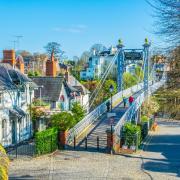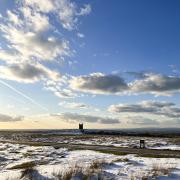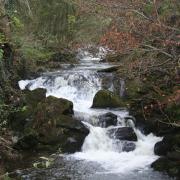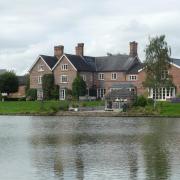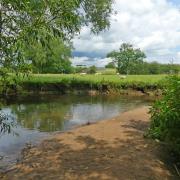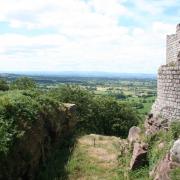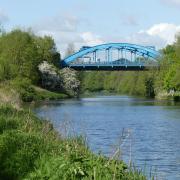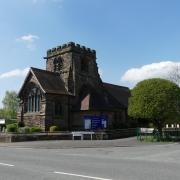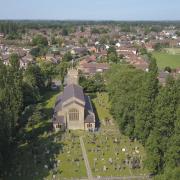A very easy walk this month; just an excuse, in truth, to return to one of my favourite places, Parkgate in Wirral

This walk was published in March 2019, so the details of the route may no longer be accurate, we do advise these articles should only be used as a guideline for any potential route you take and you should double check an up to date map before you set off.
Parkgate is one of Britain's most unusual seaside resorts. Why? Because the sea deserted it. The silting up of the Dee estuary meant that the sands disappeared beneath marsh grass which grew all the way up to the sea wall.
Where once the view from the promenade was of children taking donkey rides on the beach, and fishing boats setting off in search of dabs, herring and shrimps, now that vista is filled with greenery, and the odd pond, fizzing with birdlife. Only an occasional high tide brings the sea close to Parkgate's promenade.
Happily, Parkgate didn't let a lack of sea stop it being a seaside resort. It still has places to stay, tea shops, a cheery chippie, ice cream parlours, big-sky views and bracing air. It also has that quality all the most enduring British seaside resorts have: a sense of its own history.

For this, implausibly, was once the ferry port where Handel disembarked as he returned from the first performance of The Messiah in Dublin in 1742. John Wesley preached here, also en route to Ireland. The artist JMW Turner came here, and no doubt sighed at the broad magnificence of the view across the estuary to Wales.
The mistress of Lord Nelson - Emma, Lady Hamilton, who was born at nearby Ness - visited Parkgate in 1784 to apply healing salt water to a 'disfiguring eruption of her skin'. And tourists like her came in even greater numbers in the 19th century when Parkgate's decline as a port was balanced by the rise in its leisure economy. Parkgate even had open-air baths until the middle of the last century.
You will find some of that history in information displays on The Parade, and in plaques erected as part of Parkgate Heritage Trail. So after this short walk, take some time to explore.

1. Head for The Parade in Parkgate (postcode CH64 6SS in the sat nav will get you there) and you will find free on-street parking, and also a car park on School Lane, just a few yards from the restaurant No 1 Mostyn Square. Head north along The Parade, which means keeping the estuary on your left side. Look out for various Parkgate Heritage Trail plaques on houses, including Pengwern and Sawyer's Cottage, the oldest houses in the village, pre-dating 1700, and The Old Watch House, which once housed customs officers keeping an eye on the nautical comings and goings, and now juts into the road causing the odd traffic jam at busy times.
When you reach The Boat House - a black and white pub - the road veers right, but you carry straight on alongside the pub towards The Old Baths car park. Continue through the car park and find the path which returns you to the sea wall. Keep to this path for half a mile, passing Heswall Golf Club on your right.
2. Eventually the path curves inland to a short flight of steps, bringing you to Cottage Lane. Head up the lane, crossing over the Wirral Way, and past the entrance drive to the golf club, shortly after which you reach a T junction. Bear right into the cobbled Gayton Farm Road. You soon reach a wide unmade track. Go right on this track, following it downhill. The golf club will appear again on your right. The path narrows, just after passing two field gates to the left of it, and bears slightly right into a more thickly-wooded section. Keep ahead, skirting the top perimeter of the golf club. You pass a footpath on the right, which goes downhill through the golf course. Ignore it and keep ahead. As the path emerges from the trees, look for a little sign warning about golf balls and directing you to a short stretch of path on the left where you find a gate.

3. Go straight across the field ahead to find another gate, a bridge over a small stream, and another gate, after which the path goes up a short hill to emerge, through yet another gate, on an unmade lane near a farm. Keep ahead in the same direction, following the footpath sign on the gate post, and follow this wide track - with crop fields either side and panoramic views down to the Dee estuary - for some time until, after passing beside a large black metal gate, it reaches Boathouse Lane. Cross the road and head along Wood Lane opposite.
4. After a few minutes, you pass Brook Lane on the left. Soon after, take a path on the right, signposted Neston. Pass beneath the old railway bridge, and continue past Parkgate Primary School, keeping to this road until you reach an opening on the left, signposted Mostyn Gardens nos 7, 8 and 9. Take this path, passing a park on your left, and when you reach a crossroad of paths soon after, bear right. You will see the estuary ahead, and the path emerges on The Parade.
Compass points
Area of walk: Parkgate and Gayton
Distance: Three and a half miles
Time to allow: Two hours
Map: OS Explorer 266
Refreshments: The Little Tea House, South Cottage, The Parade, Parkgate CH64 6SA; No 1 Mostyn Square, 1 Mostyn Square, Parkgate CH64 6SL; The Ship, The Parade, Parkgate, CH64 6SA
Paul will be back next month with a walk around the Little Budworth area and the Macclesfield Canal but if you can't wait that long log onto cheshirelife.co.uk where you'll find more walks to enjoy around the county. And don't forget your camera - your pictures could win you prizes. See online for full details of our readers' photos competition and to see the entries we've already received.






